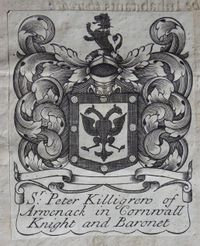Difference between revisions of "Peter Killigrew ca.1634-1705"
m (Text replacement - "Category:Illustrated" to "") |
|||
| Line 25: | Line 25: | ||
[[Category:Inscriptions]] | [[Category:Inscriptions]] | ||
[[Category:Members of Parliament]] | [[Category:Members of Parliament]] | ||
| − | |||
Revision as of 22:15, 21 July 2020
Sir Peter KILLIGREW, 2nd baronet ca.1634-1705
Biographical Note
Son of Sir Peter Killigrew of Arwennack, Cornwall, a long-established Cornish family there in what grew to be Falmouth (the elder Peter received Charles II's charter to establish the town in 1661). Matriculated at Queen's College, Oxford 1650, but did not graduate; travelled in Europe in the mid-1650s. Elected MP for Camelford 1660, but the election was declared void in the same year, and he did not stand again. Inherited the baronetcy title in 1668 on the death of his uncle. He was involved in various Cornish administrative affairs and continued his father's work in developing the town of Falmouth. His wife, Frances, was the daughter of the antiquary Sir Roger Twysden.
Books
Killigrew had an engraved armorial bookplate (Franks 17142), but the extent of his library is not known. In his will, he bequeathed all his books, along with all the rest of his household goods, to his wife, to be disposed of as she thought fit; the Arwennack estate passed to his daughter.
Characteristic Markings
Killigrew's bookplate is found on the title leaf verso of a copy of Camden's Remains, 1629, which has notes in more than one hand on the rear flyleaf, occasional marginal notes, and "Peter Killigrew his book" on the front flyleaf (could be either the father or the son?). A copy of The gentlemans calling, 1675, Maggs 1705 (1987)/78, also had the bookplate on the title leaf verso and a high quality contemporary binding (Queens' Binder A).
Sources
- Will of Peter Killigrew, The National Archives PROB 11/480/264.
- History of Parliament.
- Lee, B. N. British bookplates, 1979, no.29.
